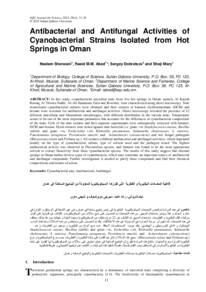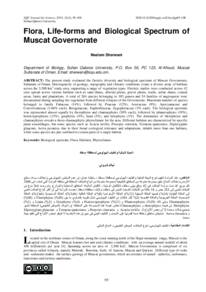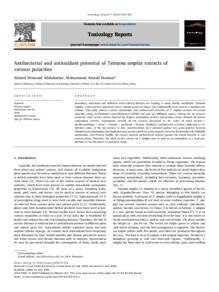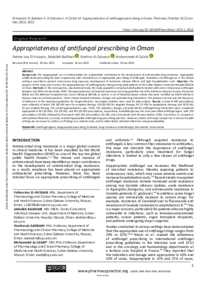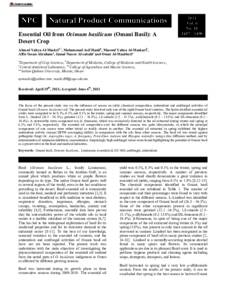وثيقة
Antibacterial and antifungal activities of cyanobacterial strains Isolated from hot springs in Oman.
المعرف
https://doi.org/10.24200/squjs.vol20iss1pp11-19
المصدر
Sultan Qaboos University Journal for Science. v. 20, no. 1, p. 11-19.
المساهمون
الدولة
Oman.
مكان النشر
Muscat.
الناشر
College of Science, Sultan Qaboos University.
ميلادي
2015-01-01
اللغة
الأنجليزية
الملخص الإنجليزي
In this study, cyanobacterial microbial mats from five hot springs in Oman, namely Al Kasfah Rustaq, Al Thwara Nakhl, Al–Ali Hammam, Gala and Bowsher, were characterized using direct microscopy. Nine monoclonal cyanobacterial cultures were obtained and their extracts in butanol, dichloromethane (DCM) and hexane were screened for antibacterial and antifungal activities. Direct microscopy revealed the presence of 12 different unicellular and filamentous morphotypes, with different distribution in the various mats. Temperature seems to be one of the most important parameters that accounts for the differences in cyanobacterial composition of the mats. Cells of the nine isolates and their aqueous supernatants were subsequently extracted with butanol, DCM and hexane. Dried extracts were tested against nine bacterial (i.e. gram +ve Staphylococcus aureus, Bacillus subtilis and gram –ve, Escherichia coli, Klebsiella pneumoniae, Salmonella choleraesuis, S. enterica, Psuedomonas aeruginosa, Providencia stuartii, and Acinetobacter calcoaceticus) and two fungal pathogens (Rhizoctonia solani and Pythium sp.). All isolates exhibited antibacterial and antifungal activities, which depended mainly on the type of cyanobacterial culture, type of solvent used and the pathogen tested. The highest antibacterial activity was observed in Phormidium species, and butanol was found to be the most appropriate solvent to extract bioactivity from these cyanobacterial species. The results of this study suggest that thermal springs in Oman harbor diverse types of cyanobacteria, which may constitute an important source of antibacterial and antifungal compounds. Further investigation is needed to purify these compounds and find their chemical compositions and modes of action.
ISSN
2414-536 X
الملخص العربي
في هذه الدراسة، وُصفت حصائر ميكروبية زرقاء من خمسة ينابيع ساخنة في سلطنة عُمان، وهي: الكسفة الرستاق، الثورة نخل، حمام العلي، غالا، وبوشر، باستخدام المجهر المباشر. تم الحصول على تسعة مزارع أحادية النسيلة للبكتيريا الزرقاء، وفُحصت مستخلصاتها في البيوتانول، وثنائي كلورو الميثان (DCM)، والهكسان للتحقق من فعاليتها المضادة للبكتيريا والفطريات. كشف المجهر المباشر عن وجود 12 نمطًا مورفولوجيًا وحيد الخلية وخيطيًا مختلفًا، بتوزيع مختلف في الحصائر. ويبدو أن درجة الحرارة من أهم العوامل التي تُفسر اختلاف تركيب البكتيريا الزرقاء في الحصائر. استُخلصت خلايا العزلات التسع ورطوبتها المائية لاحقًا باستخدام البيوتانول، وثنائي كلورو الميثان (DCM)، والهكسان. تم اختبار المستخلصات المجففة ضد تسعة أنواع من البكتيريا (أي المكورات العنقودية الذهبية الموجبة الجرام، العصوية الرقيقة والسلبية الجرام، الإشريكية القولونية، الكلبسيلة الرئوية، السالمونيلا الكوليرا، S. enterica، الزائفة الزنجارية، Providencia stuartii، و Acinetobacter calcoaceticus) واثنين من مسببات الأمراض الفطرية (Rhizoctonia solani و Pythium sp.). أظهرت جميع العزلات نشاطًا مضادًا للبكتيريا والفطريات، ويعتمد ذلك بشكل رئيسي على نوع مزرعة البكتيريا الزرقاء، ونوع المذيب المستخدم، والعامل الممرض المختبر. ولوحظ أعلى نشاط مضاد للبكتيريا في أنواع الفورميديوم، ووُجد أن البيوتانول هو المذيب الأنسب لاستخلاص النشاط الحيوي من هذه الأنواع. تشير نتائج هذه الدراسة إلى أن الينابيع الحرارية في عُمان تؤوي أنواعًا متنوعة من البكتيريا الزرقاء، والتي قد تُشكل مصدرًا مهمًا للمركبات المضادة للبكتيريا والفطريات. هناك حاجة إلى مزيد من البحث لتنقية هذه المركبات وتحديد تركيبها الكيميائي وآليات عملها.
قالب العنصر
مقالات الدوريات

